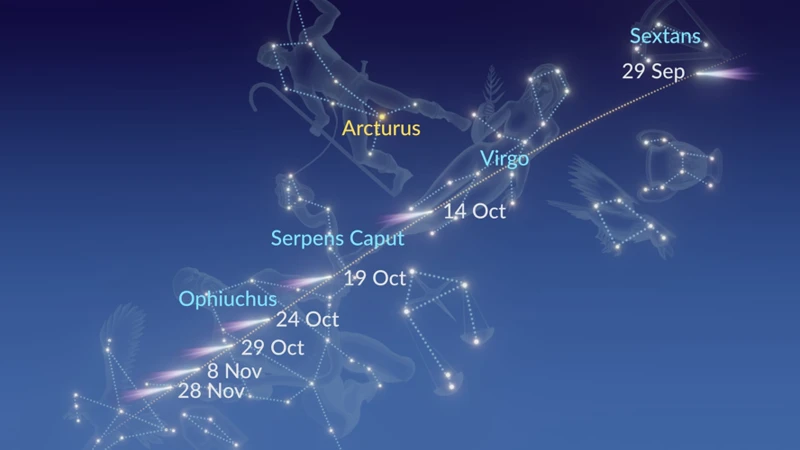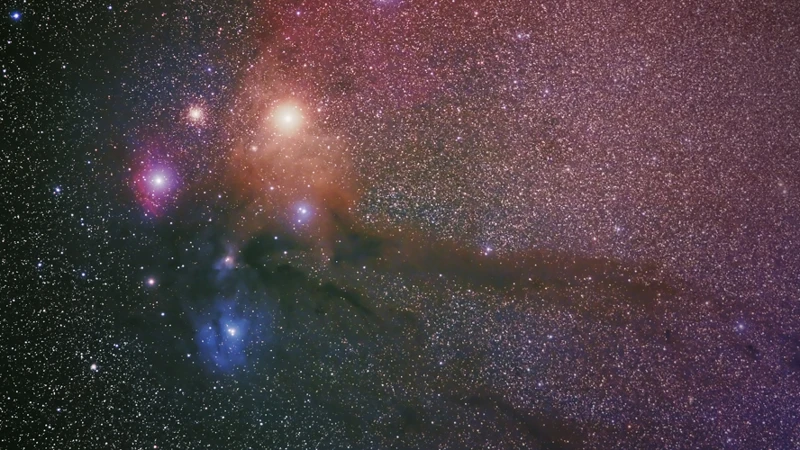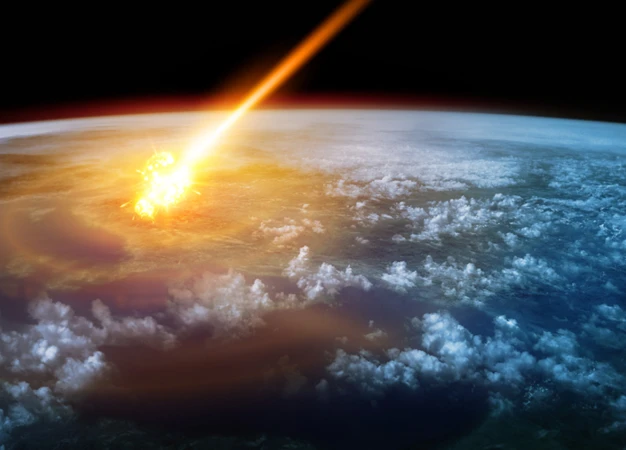It’s a natural inclination for the human mind to ponder the mysteries of the cosmos and how they relate to our existence on Earth. One of the most intriguing phenomena that has captivated civilizations throughout history is the appearance of comets. These celestial bodies, consisting of ice, rock, dust, and gas, have sparked wonder and fascination but have also instilled a sense of fear and uncertainty. In this article, we delve into the impact of comets on Earth, exploring their historical significance, potential threats, monitoring techniques, and the future of cometary impacts. Join us on this journey to unravel the mysteries of comets and their implications for our planet.
Contents
- Historical Impact of Comets
- Comets: A Potential Threat
- Monitoring and Studying Comets
- The Future of Cometary Impacts
- Conclusion
-
Frequently Asked Questions
- 1. How long have humans been studying comets?
- 2. Do comets pose a threat to Earth?
- 3. Can comets cause mass extinctions?
- 4. How do scientists monitor and study comets?
- 5. What is the importance of cometary missions?
- 6. Can comets be deflected from their path?
- 7. Are there any known upcoming cometary events?
- 8. How do comets contribute to our understanding of the solar system?
- 9. Can comets provide clues about the origins of water on Earth?
- 10. Are there any famous comets throughout history?
- References
-
Frequently Asked Questions
- 1. How do comets form?
- 2. What causes comets to have tails?
- 3. Has a comet ever caused mass extinctions on Earth?
- 4. How do scientists detect and track comets?
- 5. Are there any comets currently being monitored for potential impact with Earth?
- 6. Can comets be deflected or destroyed to prevent impact with Earth?
- 7. Are there any known comets that will pass close to Earth in the near future?
- 8. What can studying comets tell us about the early solar system?
- 9. Do comets pose any potential benefits to Earth?
- 10. What are the chances of a catastrophic comet impact in the future?
- References
- Read More
Historical Impact of Comets

Throughout history, comets have left an indelible mark on human civilization, both in terms of their awe-inspiring beauty and their perceived significance as celestial omens. Ancient cultures meticulously recorded their observations of comets, attributing them with mystical and supernatural powers. These records not only provide insights into the historical impact of comets but also offer valuable scientific data.
The ancient Egyptians, Mesopotamians, Chinese, and Greeks meticulously documented sightings of comets, often associating them with the arrival of significant events or the imminent dawning of an era. The Egyptian Pharaohs believed comets were divine messengers, while the Chinese referred to them as “broom stars” sweeping away negative energy. These observations, although steeped in mythology and superstition, laid the foundation for future scientific exploration.
One of the most famous historical cometary events is the appearance of Halley’s Comet. Chinese astronomers recorded its visits as early as 240 BC. The comet’s return in 1066 AD coincided with the Battle of Hastings, a significant event in medieval history. Another notable cometary event is the appearance of Comet Hale-Bopp in 1997, which was visible to the naked eye for a record-breaking 18 months. These historical cometary events continue to fascinate scientists and astronomers, providing essential data for further research and understanding.
The historical impact of comets extends beyond their fleeting appearances in the night sky. These celestial wonders have influenced religious beliefs, shaped cultural narratives, and even motivated scientific advancements. By studying ancient records and notable cometary events, we gain a deeper appreciation for the profound impact that comets have had on human history and the development of our understanding of the cosmos.
1.1 Ancient Records and Observations
Ancient records and observations of comets provide us with a fascinating glimpse into the mindset and beliefs of civilizations past. The ancient Egyptians meticulously documented their celestial observations, including comets, on the walls of temples and tombs. These records, inscribed with hieroglyphics, not only serve as a historical account but also shed light on the significance attributed to comets by the Egyptians. They believed that comets were a celestial manifestation of the gods and often associated their appearances with important events such as the birth or death of a pharaoh.
Similarly, the ancient Greeks were keen observers of celestial phenomena, including comets. Greek philosophers like Aristotle and Pythagoras theorized about the nature of comets, postulating that they were celestial bodies made of different elements. Greek astronomers like Hipparchus studied the movements of comets and attempted to predict their appearances.
In ancient China, comets held great importance and were interpreted as omens representing the will of heaven. Chinese astronomers meticulously recorded the appearances of comets and correlated their sightings with significant events in history. The Chinese believed that comets were a sign of impending doom, often associated with the fall of dynasties or the outbreak of wars.
The knowledge gained from these ancient records and observations has been invaluable in the study of comets and our understanding of their historical impact. These records provide a window into the beliefs, culture, and scientific advancements of ancient civilizations. By studying the ancient records and observations, we not only gain insight into the impact of comets on early societies but also uncover a fascinating chapter in the history of human civilization.
1.2 Notable Cometary Events in History
Notable cometary events in history have left a lasting impact on human civilization, shaping our understanding of these celestial wonders and their significance. One such event is the appearance of Halley’s Comet, named after astronomer Edmond Halley, who predicted its return based on historical observations. Halley’s Comet is known for its regular appearances, with the most recent visible from Earth in 1986. Its sightings throughout history have been documented by various cultures, including the Chinese and the ancient Greeks.
Another remarkable cometary event is the Great Comet of 1811. This spectacular comet was visible to the naked eye for several months and had a remarkably long tail. Its appearance captivated the public and inspired artists and writers of the time, including the renowned American painter John Quincy Adams Ward.
In more recent history, the appearance of Comet Hale-Bopp in 1997 garnered significant attention and public interest. This comet had a remarkably bright and distinct nucleus, making it visible to the naked eye for an extended period. Astronomers and skywatchers around the world marveled at its beauty and eagerly studied its composition.
These notable cometary events serve as reminders of the wonders of the universe and the impact that celestial bodies can have on our collective imagination. By studying and documenting these events, scientists and astronomers gain valuable insights into the nature of comets, their behavior, and their role in the cosmic ecosystem. Understanding the historical significance of cometary events not only deepens our appreciation for the beauty of the night sky but also contributes to our understanding of the universe and its celestial phenomena.
Comets: A Potential Threat

Comets, while captivating in their celestial beauty, also pose a potential threat to life on Earth. Throughout history, comets have been associated with disaster and cataclysmic events. This perception stems from the understanding that comets are unpredictable and can potentially collide with our planet, causing widespread devastation.
Comets are composed of volatile substances such as ice and gases, which can vaporize upon entering Earth’s atmosphere. The release of this gas can create a glowing coma and a distinct tail, adding to the comet’s majestic appearance. However, it is this very composition that makes comets potentially hazardous.
The most well-known theory relating comets to mass extinctions is the impact of a comet or asteroid, according to the Alvarez Hypothesis, that is widely believed to have caused the extinction of dinosaurs. The debris and intense heat generated by a large cometary impact would have had catastrophic effects on Earth’s ecosystems, leading to widespread destruction and loss of life. While such events are rare, they underscore the potential threat comets can pose to our planet.
To better understand and mitigate these potential threats, scientists have developed various methods for monitoring and tracking comets. Advanced telescopes and observatories allow for early detection of potentially hazardous comets, providing valuable data to assess their trajectories and potential impact. The use of space missions and probes, such as NASA’s Stardust and ESA’s Rosetta missions, has allowed for close-up observations and sample collection from comets.
Although the risk of a catastrophic comet impact is relatively low, the identification and monitoring of comets remain vital for planetary defense and our understanding of the dynamics of the cosmos. By studying and preparing for the potential threat of comets, we can strive to protect our planet and ensure the continuation of life as we know it.
2.1 Comets as Harbingers of Disaster
Comets have long been associated with doom and disaster in human history. Their sudden appearances in the sky, often accompanied by a bright tail, have struck fear and uncertainty into the hearts of people throughout the centuries. In ancient times, cometary sightings were often interpreted as signs of impending calamities and catastrophes. These beliefs were deeply rooted in cultural and religious ideologies, inspiring legends, and prophecies.
One notable example is the comet that appeared in 1066 as Halley’s Comet made its journey through Earth’s orbit. This event coincided with the Battle of Hastings, which led to the Norman conquest of England. The appearance of the comet was perceived as a premonition of the impending conflict and the turbulent times that followed. Similar associations between comets and disasters can be found in different cultures and historical periods.
Ancient civilizations believed that comets were messengers of the gods, announcing impending doom, wars, and hunger. Astronomical events like eclipses, meteor showers, and comets served as a physical manifestation of the divine and were often interpreted as omens. The fear and anxiety caused by these celestial events spurred societies to take action, such as performing rituals, offering sacrifices, or seeking divine intervention to avert potential disaster.
However, with the advancement of scientific knowledge, our understanding of comets has evolved. Today, we recognize that comets pose no direct threat to life on Earth. They are simply celestial bodies orbiting the Sun, composed of ice, dust, and various organic compounds. While the appearance of a comet may still captivate our imagination and curiosity, it is no longer regarded as a harbinger of disaster. Instead, comets provide valuable scientific data that helps us unravel the mysteries of our universe and its origins.
2.2 The Role of Comets in Mass Extinctions
When considering the impact of comets on Earth, one of the most significant and concerning aspects is their potential role in mass extinctions. The idea that cometary impacts could have caused catastrophic events leading to the extinction of numerous species has long intrigued scientists and sparked heated debates. One of the most well-known examples often cited in this context is the extinction event that occurred approximately 66 million years ago, marking the end of the Cretaceous period and the demise of the dinosaurs. It is widely believed that a comet or asteroid impact played a vital role in this event. The Chicxulub crater in Mexico, with its undeniable evidence of an extraterrestrial impact, has been closely linked to the mass extinction event. This cataclysmic event led to widespread devastation, including massive wildfires, tsunamis, and an abrupt change in climate. The resulting environmental changes, such as reduced sunlight due to debris in the atmosphere, likely caused the collapse of ecosystems and a significant loss of biodiversity. While the precise nature and extent of cometary involvement in mass extinctions are still the subject of ongoing research and scientific investigation, it is clear that comets have the potential to unleash immense destructive power and alter the course of life on Earth. Understanding this risk is crucial for developing strategies to mitigate potential future impacts and ensure the long-term survival of our planet and its inhabitants.
Monitoring and Studying Comets

Exploring and studying comets is a challenging endeavor that requires advanced technology and innovative techniques. Modern astronomers employ various methods to monitor and study these fascinating celestial bodies, aiming to unravel their mysteries and gain insight into their composition, behavior, and potential impact on Earth.
Modern Techniques for Comet Observation:
1. Telescopic Observations: Astronomers use powerful telescopes equipped with advanced optics and imaging capabilities to observe comets from Earth. These observations provide valuable information about the size, shape, and trajectory of comets, as well as their composition and the presence of gas and dust tails.
2. Space-based Observatories: Space missions dedicated to studying comets, such as the European Space Agency’s Rosetta mission, have provided unprecedented close-up observations. These missions allow scientists to analyze the nucleus of comets, study their surface features, and analyze the composition of the gases and dust emitted by comets.
3. Remote Sensing: Spectroscopy, a technique that analyzes the interaction between light and matter, is employed to examine the composition of comets. By analyzing the wavelengths of light emitted or absorbed by cometary gases and dust, scientists can identify specific elements and molecules present in the cometary material.
Importance of Cometary Missions:
Cometary missions play a crucial role in advancing our understanding of comets. These missions provide direct access to comets, allowing scientists to study them up close and collect invaluable data. The collected data helps scientists investigate the origins and evolution of comets, shedding light on the early solar system’s conditions and the building blocks of life. Additionally, cometary missions contribute to our understanding of the potential threat comets pose to Earth, allowing for better risk assessment and the development of strategies to mitigate potential impacts.
While monitoring and studying comets is a complex scientific endeavor, each observation and mission brings us closer to unraveling the mysteries of these celestial wanderers. The knowledge gained from these studies not only expands our understanding of comets but also enhances our understanding of the universe and the role comets have played in shaping the history and evolution of our planet.
3.1 Modern Techniques for Comet Observation
Modern astronomers and scientists have developed advanced techniques for observing comets, allowing for a more comprehensive understanding of these enigmatic celestial bodies. A wide range of observational tools and technologies are utilized to study comets in detail.
Ground-based observatories equipped with powerful telescopes play a crucial role in tracking the movement of comets and capturing detailed images. These telescopes are often equipped with specialized filters and sensors to detect specific wavelengths of light emitted by comets. By analyzing these emissions, scientists can determine the composition of the comet’s nucleus and its surrounding atmosphere.
In addition to ground-based observations, space-based telescopes have provided invaluable insights into comet behavior. Instruments such as the Hubble Space Telescope have captured high-resolution images, revealing intricate details of the comet’s structure and dynamics. For example, the Deep Impact mission, which launched a probe into Comet Tempel 1, provided scientists with unprecedented close-up images of a comet’s nucleus, enhancing our understanding of its composition and formation.
Advanced spectroscopic techniques enable scientists to analyze the light emitted or reflected by comets. By studying the specific wavelengths of light, astronomers can identify the chemical elements present in the comet’s coma and tail. This information provides important clues about the origins of comets and the conditions in the early solar system.
Modern techniques for comet observation also involve the use of space missions specifically designed to rendezvous with comets. One such mission is the European Space Agency’s Rosetta mission, which successfully landed a probe on Comet 67P/Churyumov-Gerasimenko in 2014. The mission provided an unprecedented opportunity to study the properties and behavior of a comet up close, furthering our understanding of these intriguing objects.
By harnessing the power of advanced telescopes, spectroscopic analysis, and space missions, scientists continue to refine their understanding of comets. These modern techniques not only expand our knowledge of comets as individual objects but also contribute to our broader understanding of the formation and evolution of the solar system as a whole. Through ongoing observation and exploration, scientists are unraveling the mysteries of comets, shedding light on their origin and potential impact on Earth.
3.2 Importance of Cometary Missions
Cometary missions play a crucial role in our understanding of comets and their potential impact on Earth. These missions involve sending spacecraft to rendezvous with comets, studying their composition, structure, and behavior up close. The importance of these missions cannot be overstated, as they provide valuable insights into the origins of comets and their potential threat to our planet.
One of the most significant cometary missions to date is the European Space Agency’s Rosetta mission. Launched in 2004, Rosetta successfully reached its target, Comet 67P/Churyumov-Gerasimenko, in 2014. The mission provided unprecedented data on the comet’s composition, shedding light on the building blocks of our solar system and the role comets may have played in the origin of life on Earth.
Another noteworthy cometary mission is NASA’s Stardust mission. Stardust collected samples from the coma (a cloud of gas and dust surrounding the nucleus) of Comet Wild 2 and returned them to Earth for analysis. This mission revealed the presence of organic molecules, including amino acids, on the comet’s surface, bolstering the theory that comets may have delivered the building blocks of life to our planet.
Cometary missions not only provide us with valuable scientific data but also offer crucial insights into potential mitigation strategies for future cometary impacts. By studying the composition and structure of comets, scientists can better understand their behavior and develop techniques to divert or mitigate their impact if necessary. These missions serve as stepping stones towards developing the technology and knowledge needed to protect our planet from potential cometary threats.
With ongoing advancements in space exploration technology, future cometary missions hold great promise for uncovering even more profound insights into the nature of these celestial objects and their impact on Earth. By continuing to invest in cometary missions, we can expand our scientific knowledge and enhance our ability to predict and mitigate potential cometary threats in the future.
The Future of Cometary Impacts

Predicting and assessing the risk of future cometary impacts is a crucial aspect of ensuring the safety and well-being of our planet. Astronomers and scientists continually strive to monitor and track potentially hazardous comets that may pose a threat to Earth. New advancements in technology and space missions have provided us with the tools to better understand these cosmic objects and develop strategies for deflection and mitigation in the future.
To assess the risk of future cometary impacts, scientists analyze various factors such as the size, composition, and trajectory of comets. By studying their orbits, astronomers can identify the potentially hazardous comets that come close to Earth’s path. The Near-Earth Object (NEO) program plays a vital role in tracking these celestial bodies and providing data for further analysis. Additionally, space-based telescopes such as the Hubble Space Telescope and the upcoming James Webb Space Telescope offer enhanced capabilities for observing and characterizing comets.
In the future, there may be a need for deflection and mitigation strategies to protect Earth from potential cometary impacts. One proposed method is the use of spacecraft to divert the path of a threatening comet. The European Space Agency’s HERA mission aims to study the effects of a kinetic impactor on a small moonlet of a binary asteroid, providing insights into the possibility of altering the trajectory of a comet. Other strategies, such as using gravity assists or even nuclear detonation, have been proposed as well but would need careful consideration and exploration of their feasibility.
As our understanding of comets and their potential impacts continues to evolve, it is essential to stay vigilant and proactive in monitoring and studying these celestial objects. By harnessing technological advancements and conducting further missions to study comets up close, we can better understand their behavior and composition. The future holds exciting opportunities for scientific exploration and safety measures to minimize the potential impact of comets on Earth, ensuring a brighter and safer future for humanity.
4.1 Assessing the Risk of Future Impacts
Assessing the risk of future impacts from comets is a vital scientific endeavor that allows us to better understand and prepare for potential catastrophic events. Scientists employ various methods to evaluate the likelihood of such impacts and the potential consequences they may entail. One approach involves cataloging and monitoring near-Earth objects (NEOs), which include comets that come into close proximity with our planet’s orbit. The International Astronomical Union (IAU), in collaboration with numerous observatories worldwide, maintains databases of known NEOs and continuously tracks their trajectories using advanced telescopes and radar systems. This ongoing monitoring allows scientists to assess the potential threat level posed by each NEO and determine the probability of future impacts. Another crucial aspect of risk assessment involves modeling the potential consequences of a cometary impact. By simulating different impact scenarios, scientists can estimate the potential damage, such as the extent of shockwaves, firestorms, and tsunamis, which helps in formulating appropriate response strategies. Studying the composition and characteristics of comets themselves provides vital insights into their destructive potential. Missions like the European Space Agency’s Rosetta mission, which studied comet 67P/Churyumov-Gerasimenko, have greatly contributed to our understanding of cometary compositions and structures, enabling more accurate risk assessments. Assessing the risk of future cometary impacts requires a multi-faceted approach that combines monitoring, trajectory calculations, impact modeling, and ongoing scientific research to safeguard our planet and mitigate potential catastrophic consequences.
4.2 Deflection and Mitigation Strategies
Deflection and mitigation strategies play a crucial role in assessing and managing the potential risks posed by cometary impacts on Earth. As our understanding of comets has evolved, so too have our efforts to develop methods to divert and mitigate the destructive consequences of a potential impact.
One potential strategy involves the use of spacecraft to intercept and redirect a comet away from a collision course with Earth. This concept, known as a kinetic impactor, involves striking the comet with a spacecraft to alter its trajectory. By imparting a small change in momentum to the comet, scientists hope to deflect it away from our planet. NASA’s Deep Impact mission in 2005 tested this concept by deliberately colliding with Comet Tempel 1, providing valuable data for future deflection missions.
Another approach to deflection and mitigation is the use of gravity tractors. This method involves positioning a spacecraft near the comet to utilize its gravitational pull and gradually alter the comet’s path over time. By applying a gentle, sustained gravitational attraction, the spacecraft can slowly veer the comet away from Earth’s orbit.
Ongoing research explores the potential of utilizing nuclear explosives to deflect comets. This controversial approach involves detonating a device near the comet, causing a small but significant change in its trajectory. While the feasibility and ethical implications of nuclear deflection strategies continue to be debated, they remain a topic of interest in the scientific community.
Aside from deflection strategies, mitigation efforts focus on minimizing the impact effects in case of an unavoidable collision. This includes early warning systems to provide sufficient time for evacuation, developing response plans for affected areas, and strengthening infrastructure to withstand the impact and subsequent effects.
Studying and developing deflection and mitigation strategies are crucial steps in safeguarding our planet from the potential devastation caused by cometary impacts. While significant progress has been made, continued research and investment into these strategies are imperative to enhance our ability to protect Earth and its inhabitants from future cometary threats.
Conclusion

In conclusion, the impact of comets on Earth is a topic that encompasses both ancient history and future possibilities. Throughout the ages, comets have served as harbingers of significant events, their appearances recorded and interpreted by ancient civilizations. These historical observations have not only enriched our cultural narratives but also provided valuable scientific data for studying these celestial bodies.
Looking ahead, understanding the potential threats posed by comets is crucial. The role of comets in mass extinctions highlights the need for continued monitoring and study. Advanced techniques for comet observation and the importance of space missions dedicated to studying comets have allowed scientists to gather valuable information about these cosmic wanderers.
As we assess the risk of future impacts and develop strategies for deflection and mitigation, the knowledge gained from historical records and modern research is invaluable. It is essential to continue monitoring cometary activity and advancing our understanding of these celestial visitors to better protect our planet.
In the grand tapestry of the universe, comets hold a captivating allure. From ancient civilizations who revered them as divine manifestations to modern scientists unravelling their mysteries, comets continue to leave an indelible mark on our collective consciousness. With ongoing research and exploration, we can unlock further insights into comets’ past and their potential impact on our future. Let us embrace the wonder and intrigue of comets, for they remind us of the boundless mysteries that lie beyond our celestial shores.
Frequently Asked Questions

1. How long have humans been studying comets?
Humans have been studying comets for thousands of years. Ancient civilizations, such as the Egyptians, Mesopotamians, and Chinese, meticulously recorded their observations and interpretations of comets.
2. Do comets pose a threat to Earth?
While the chances of a catastrophic comet impact are extremely low, comets do pose a potential threat to Earth. Their unpredictable nature and large sizes make it essential to monitor and study them.
3. Can comets cause mass extinctions?
There is evidence to suggest that comets played a role in some mass extinctions in Earth’s history. However, these events are rare and not the sole cause of mass extinctions throughout history.
4. How do scientists monitor and study comets?
Scientists use a variety of techniques to monitor and study comets. Ground-based telescopes, space-based observatories, and dedicated comet missions provide valuable data about their composition, structure, and trajectories.
5. What is the importance of cometary missions?
Cometary missions, such as the European Space Agency’s Rosetta mission, provide scientists with the opportunity to study comets up close. These missions have yielded valuable insights and data about the nature of comets.
6. Can comets be deflected from their path?
While it is theoretically possible to deflect a comet from its path, the technology and methods to do so are still being developed. Deflection strategies may involve spacecraft impact, gravity assist, or even altering a comet’s composition.
7. Are there any known upcoming cometary events?
As of now, there are no known cometary events that pose a significant threat to Earth. However, ongoing monitoring and observations continue to uncover new comets and provide scientists with valuable data.
8. How do comets contribute to our understanding of the solar system?
Comets are considered remnants from the early stages of the solar system’s formation. By studying their composition and structure, scientists can gain insights into the origins of our solar system and the conditions that gave rise to life on Earth.
9. Can comets provide clues about the origins of water on Earth?
Comets are often referred to as “dirty snowballs” because of their high water content. Studying the water and molecular composition of comets can provide valuable clues about the origins of water on Earth and its role in the development of life.
10. Are there any famous comets throughout history?
Yes, there are several famous comets throughout history. Halley’s Comet, with its predictable return every 76 years, is one of the most well-known. Other famous comets include Comet Hale-Bopp, Comet Shoemaker-Levy 9 (which collided with Jupiter in 1994), and Comet McNaught.
References
Frequently Asked Questions

1. How do comets form?
Comets are formed from a mixture of rock, dust, ice, and organic compounds. These materials come together in the outer regions of the solar system, where they form icy bodies known as comets.
2. What causes comets to have tails?
When a comet gets close to the Sun, heat causes the icy nucleus to vaporize, releasing gases and dust. The Sun’s radiation pressure and the solar wind then push these materials away from the nucleus, creating the characteristic tail of a comet.
3. Has a comet ever caused mass extinctions on Earth?
While the notion of a comet causing mass extinctions is still a topic of scientific debate, some researchers believe that a large comet impact could have contributed to certain extinction events in Earth’s history, such as the one that killed off the dinosaurs.
4. How do scientists detect and track comets?
Scientists use a variety of techniques to detect and track comets, including ground-based telescopes, space missions, and observatories. These instruments help scientists study the movement, composition, and behavior of comets as they approach the inner solar system.
5. Are there any comets currently being monitored for potential impact with Earth?
Yes, there is an ongoing effort to monitor and track comets that could potentially pose a threat to Earth. Astronomers and space agencies around the world collaborate to identify and study any comets that come close to our planet.
6. Can comets be deflected or destroyed to prevent impact with Earth?
There are various proposed methods for deflecting or mitigating the impact threat of comets. These include using gravitational assists, nuclear detonations, and laser ablation techniques to alter the course of a comet or break it apart before it reaches Earth.
7. Are there any known comets that will pass close to Earth in the near future?
As of now, there are no known comets that will pass extremely close to Earth in the immediate future. However, new comets are discovered regularly, and their trajectories are continuously monitored to ensure the safety of our planet.
8. What can studying comets tell us about the early solar system?
Comets are considered relics from the early solar system, containing preserved molecules and materials that have remained relatively unchanged for billions of years. By studying comets, scientists can gain insights into the conditions and processes that led to the formation of our solar system.
9. Do comets pose any potential benefits to Earth?
Comets contain valuable resources such as water, organic compounds, and metals. Mining and utilizing these resources from comets could potentially provide a sustainable source of raw materials for future space exploration and colonization efforts.
10. What are the chances of a catastrophic comet impact in the future?
The chances of a catastrophic comet impact in the future are relatively low. With advanced monitoring systems and ongoing research, scientists can identify potential threats and develop strategies to mitigate the risk of a destructive comet impact on Earth.







